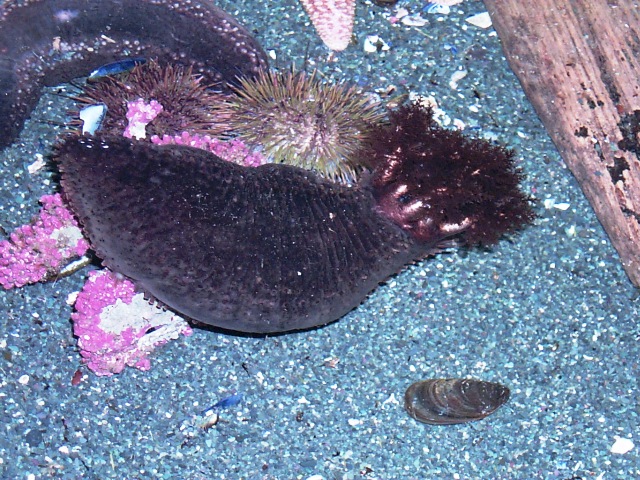Orange Footed Sea Cucumber

Scientific name: Cucumaria frondosa
Phylum: Echinodermata
Class: Holothuroidea
Description: Orange footed sea cucumbers are distinctly cucumber shaped. The skin is opaque and leathery; tube feet are in 5 bands; ten bushy tentacles are around the mouth. Young are pale orange to deep brown at front end, while adults are dark purplish or reddish brown with tube feet bright orange-tipped.
Distribution: Orange footed sea cucumbers are found from Arctic to Cape Cod, from lower inter-tidal and cold tide-pools to sub-tidal down to 1000ft.
Locomotion: Crawling is accomplished by the podia or by action of body wall muscles.
Food gathering: Orange footed sea cucumbers are suspension feeders. They extend branched and mucus covered tentacles into water to trap suspended particles including live plankton. Tentacles then are pushed to mouth. When threatened, sea cucumbers fill up with water and stretch out as much as they can to make it harder for the predator to capture them. They will also wriggle and roll away from predators.
Gas exchange: Water is pumped in and out of the hind-gut and branches of respiratory trees; and gases are exchanged between the water and coelom and hemal system.
Reproduction: The sexes are separated, with eggs being fertilized externally. They also have a free-swimming larval stage. They are unique among echinoderms in possessing a single gonad that opens the outside between two pairs of tentacles.
Interesting facts: Sea cucumbers are processed into "beche-de-mer" by boiling and drying and are sold in Asian markets.
Images
 |
 |
 |
 |
OSC Research
Mercier Lab - Masters student Justin So is working on the growth rates, predation, gene flow and health status of sea cucumbers on various substrates for the Orange Footed Sea cucumber, Cucumaria frondosa.